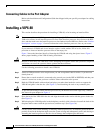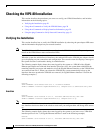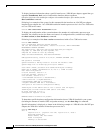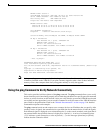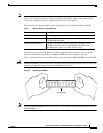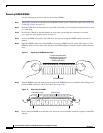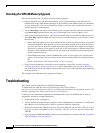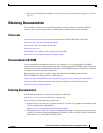
32
Versatile Interface Processor (VIP6-80) Installation and Configuration Guide
OL-5078-01
Following is an example of a successful ping command to a remote server with the IP address 10.1.1.60:
Router# ping 10.1.1.60 <Return>
Type escape sequence to abort.
Sending 5, 100-byte ICMP Echoes to 10.1.1.60, timeout is 2 seconds:
!!!!!
Success rate is 100 percent (5/5), round-trip min/avg/max = 1/15/64 ms
Router#
If the connection fails, verify that you have the correct IP address for the server and that the server is
active (powered on), and repeat the ping command.
For complete descriptions of interface subcommands and the configuration options available for
VIP6-80-related interfaces, and which commands support VIP6-80 functionality, refer to the
publications listed in the “Related Documentation” section on page 2.
Maintenance Procedures
The following sections discuss maintenance procedures you might need for your VIP6-80 and
port adapters:
• Single Line Card Reload, page 32
• Upgrading VIP6-80 Memory, page 32
• Checking the VIP6-80 Memory Upgrade, page 36
Single Line Card Reload
Single Line Card Reload (SLCR) is a feature that speeds recovery of a failed router by reloading a failed
line card without reloading other line cards on the network backplane. SLCR isolates the fault to a single
Versatile Interface Processor (VIP6-80) or legacy interface processor card (lps), and accelerates recovery
time by reloading only the faulty VIP or lps. Physical lines and routing protocols on the other line cards
of the network backplane remain active. The system continues forwarding packets with minimal
interruptions.
SLCR is disabled by default and needs to be manually configured. For more information on how to
configure SLCR, refer to the Cisco 7500 Single Line Card Reload feature module at
http://www.cisco.com/univercd/cc/td/doc/product/software/ios120/120newft/120limit/120s/120s13/slcr
.htm.
Upgrading VIP6-80 Memory
This section provides the guidelines and procedures for upgrading CPU memory (also called program
memory) and packet memory on your VIP6-80.
To upgrade CPU memory on your VIP6-80, you must replace the SDRAM DIMM located in socket U1.
To upgrade packet memory on your VIP6-80, you must replace the SDRAM DIMM located in socket
U5. (See Figure 1.) The default memory configurations for the VIP6-80 are 64 MB of CPU memory and
64 MB of packet memory.
Note To upgrade CPU memory to 256 MB, use any allowable combination of CPU memory and packet
memory. You do not need to have equal amounts of CPU memory and packet memory installed.



